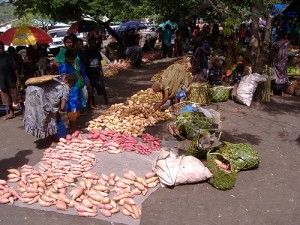Voice of America has five (count them!) articles and podcasts on the banana in Africa. Going to take me a while to get through the whole lot, but I’ll try to post a summary when I do.
Sweet potato diversity identified
Amazingly, there are people out there who can name a sweet potato variety at twenty paces. And in a photograph. Check out the comments to a recent flickr upload of mine showing a market in Rabaul. Now, if only I had geo-referenced it…

L’etat, c’est nous
We asked our friend Laurent Penet to comment on a recent news item that reported the Kokopelli Association is in hot water with the authorities again. Below is his report. Have you got something to add? Let us know.
The Association Kokopelli, a French non-profit that aims to conserve the seeds of old varieties directly with the help of gardeners and volunteers, has been declared “Persona non grata” and can no longer work with the famous Sun King’s Vegetable Garden at Versailles. The decision, by the French Agriculture ministry is a serious blow to the organization.
The decision seems to follow the sentence against Kokopelli in February 2008, when the Association was fined 23 000 euros after a case brought by the seed industry, which wanted to prevent Kokopelli from organizing a citizen-based seed bank service.
While it is true that many Kokopelli varieties are not registered on the official listing and therefore cannot be evaluated nor referenced (and thus may not be distinguishable from other varieties or genetically stable), the main issue revolves around the right to “sell”and multiply varieties. Dynamic conservation of old and therefore endangered stocks and varieties is not yet integrated in the idea of biodiversity yet.
The Ministry’s decision is even more amazing, given President Sarkozy’s declaration that French gastronomy should become part of world heritage, and the fact that even modern recipes often make abundant use of old fashioned vegetables and varieties.
Michael plays Virgil
Bioversity’s Michael Mackay was recently interviewed on Radio Australia about plans to lead us all out of genebank database hell. Good luck to him!
Cacao goes sustainable, yes, but how?
The World Cocoa Foundation is offering a guide to the cocoa industry on sustainability principles that focus on equitable profit, labour standards and environmental issues.
That’s from a press release. There’s something similar on the World Cocoa Foundations’s blog. But I can’t find anywhere on the WCF website the teach-yourself-sustainable-cacao-farming document that I was foolishly expecting.
I guess we’ll have to make do with some general aims:
The sustainability initiative commits the foundation and its members to working toward three categories; profit, people and planet.
For the people category, the aim is for healthy and thriving cocoa-farming communities, where international labour standards are followed and farming practices are safe.
The planet category refers to responsible, sound environmental stewardship in cocoa-farming communities where soil and water are conserved and Integrated Pest Management to limit the use of agricultural chemicals, protecting the fragile tropical ecosystem.
And in terms of profit, the aim is to improve equitable economic returns for farmers built upon expanding entrepreneurial skills, stronger and more effective farmer associations, and more productive, profitable farming practices.
and a bunch of example projects. Not much about the importance of genetic diversity, alas.